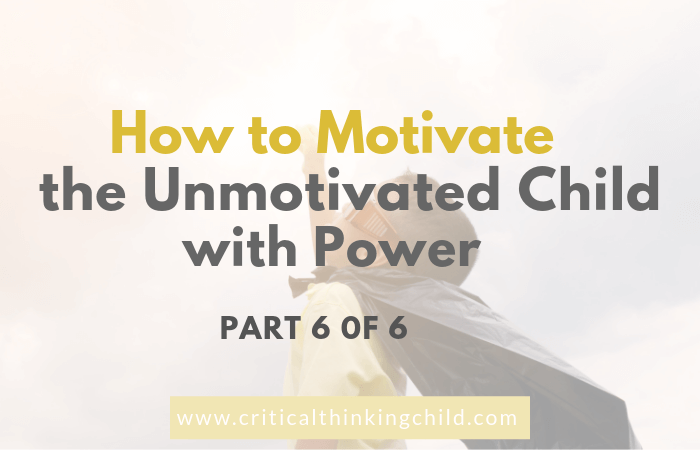The sixth and final strategy in our 6-part series on motivation is power. While this might seem like a strange tool, you’ll learn how to use power in a safe, effective way that helps your child stay motivated.
The word “power” may bring up negative connotations (such as that famous quote by John Acton, “absolute power corrupts absolutely.”), but power as a motivator centers around providing your child with choice. Students are more motivated when they have a sense of agency. Unlike adults, children are often limited in their choices. It’s the parent or teacher or mentor who decides where a child goes, what they learn, and how they spend their day. Learning how to use choice and power as a motivator may surprise you with its effectiveness.
Who is motivated by power?
Most children respond well when provided the opportunity to make choices in their lives. Even quiet, solitary children like to feel as though their opinion and decision matters. That said, power is a particularly strong motivator for more opinionated, independent children who like to feel as if they have control of their environment. In addition, unlike some of our other motivators, power can be particularly effective with children who fight or throw tantrums often.
Why does power work as a motivator?
Power works as a motivator because it allows students some level of control over their life. Many classroom and home environments are incredibly structured, which can be helpful for many children, but for others, it can result in power struggles. These children don’t feel like they have a say in what they’re doing or what happens, and that becomes frustrating for them. When they are given choices, they become more likely to complete their work or exhibit better behavior since they were involved from the beginning.
Power can also work as a “prize” after a goal is met. Instead of dictating a prize like stickers or extra recess, offer your child the chance to choose their reward. This type of minor choice can make a major difference in a student’s attitude and motivation.
How do I use power to motivate my child?
The first step to using power as a motivator is to take an inventory of your child’s interests. You may already know many of these answers, but if not, talk to your child about what they like: what are their preferred academic activities (computer time or drawing; science or writing)? What are their preferred ways of working (group vs. partner vs. individual)? What are their preferred prizes (certificate vs. prize box vs. choice activity)? This part is crucial in motivating your child. If they don’t care about the choices, they won’t feel motivated by them. This conversation can even serve as an initial motivator because it gets students excited about what’s to come.
Once you complete the interest inventory, think about how to incorporate these choices into your child’s activities. For example, they could receive a choice board for homework every night; they can choose where to do their homework, which adult they want to check their homework, and what happens when homework is done. Many adults struggle with this seeming loss of control when thinking about power as a motivator, so it’s important to only give choices you feel comfortable with. Don’t allow your child to do homework on the couch while listening to music if it will drive you crazy. Remain aware of your own preferences while also being willing to challenge your own flexibility.
It can also be helpful to communicate your findings to your child’s teacher. Many teachers are already incorporate choice-based activities, but it can be particularly helpful to communicate regularly with teachers and work as a team.
Just like people and prizes, you can also incorporate the concept of power into rewards. When you find out what types of rewards motivate your child, offer them as options for a job well done! If your child goes a week without a fight, ask them if they want to go to the park or the arcade. If they get a good grade on a spelling test, ask if they want extra TV time or extra time outside.
The two big keys to using power as a motivator is to know your child’s interests and preferences and to only allow choices that you are okay with. This will allow both children and adults to have control over the learning environment.
Motivating your unmotivated child is a process
Throughout this series we’ve talked about six different techniques for motivating your child: praise, projects, prestige, prizes, people, and power. Each of these strategies is powerful, and each represents one possible path. As your child grows, the motivational strategy they respond may change. It’s your job to be open to experimenting with different techniques and adapting with your child.
Over time, your child will likely pick up on these strategies and learn to self-motivate. And if they ever find themselves struggling to get started on a new project, finish their schoolwork, or complete chores, you can always return tools to help them succeed.




Motivating children is something each and every parent will have to do if they want them to become better people and thats why its important , great post
Yes indeed! Thanks!